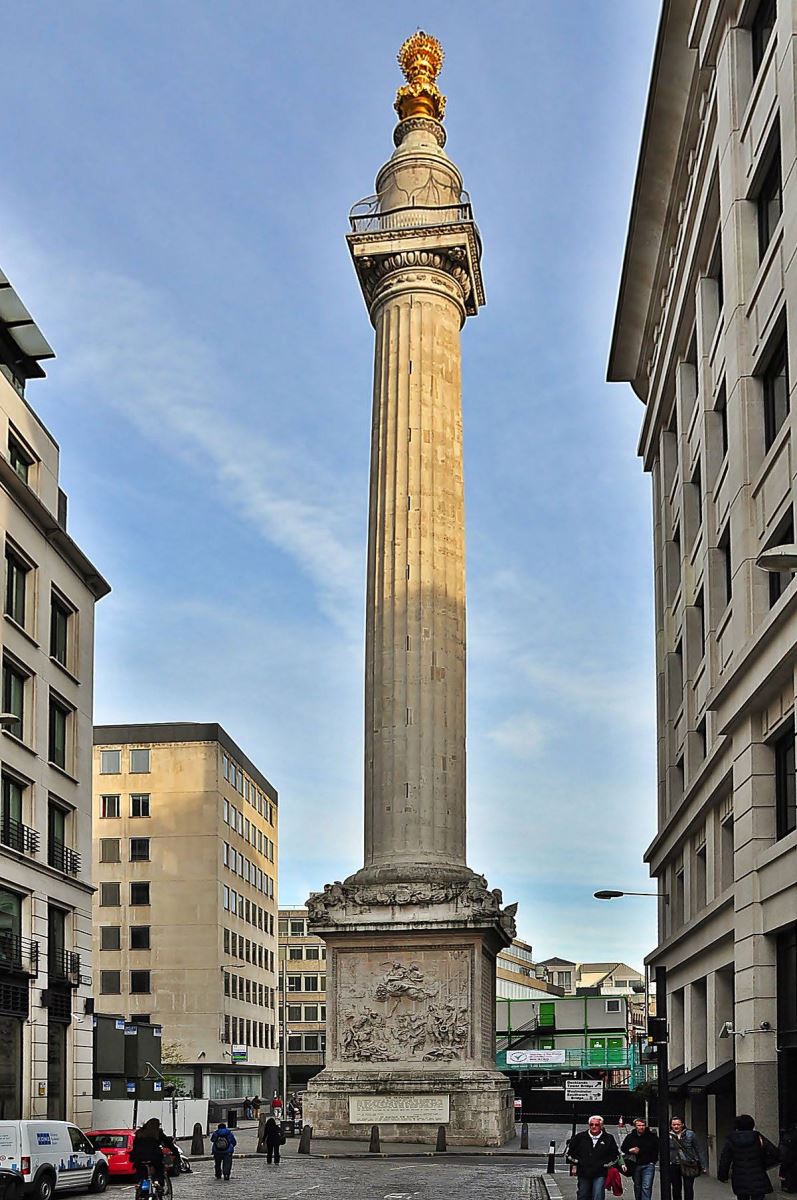《安澜老爷子的晚安故事 》-伦敦惊魂夜 !一场大火让七万人无家可归 ....


▷


1666年9月,虽是秋初但伦敦仍被夏天的干燥包裹,燥热的夜风在狭窄巷陌间穿行。布丁巷的灯火稀疏,居民们沉浸在深夜的静谧中。
无人预料到,面包店里那一点微不足道的火星,会在风势助推下迅速燎原,将这座城市的百年积淀焚烧殆尽,彻底改写它未来的全部轨迹。
建筑崩塌,几万人流离失所,家园化为灰烬...这场大火背后,是否藏着不为人知的秘密?

彼时的伦敦本就深陷鼠疫阴影,城区建筑多为木质结构,房屋密集如织、街道狭窄逼仄,为火势蔓延埋下隐患。大火带来的恐慌瞬间席卷全城,民众拖家带口仓皇逃离,昔日繁华街巷沦为火海。
事实上,就在一年前,即1665年,大瘟疫已经导致近 10万人死亡。

△点击播放音频

Tales from History with Anlan
In this segment, I’m going to share with you some of the most exciting, terrible, fascinating and funny stories from history. So, sit back, relax and come with me to a time long, long ago.

The Great Fire of London
(
1666
)
A Hot, Windy Night in Pudding Lane
On the night of Saturday, 1 September 1666, London was calm. It was early autumn, but the city was still dry and warm. That summer had been very hot, and there had been no rain for weeks. Most people in London went to sleep that night without knowing that their city was about to change forever.
In a small bakery on Pudding Lane, something went wrong. The bakery belonged to a man named Thomas Farriner, who baked bread for the English navy. Before he went to bed, he put out his fire, as all bakers were supposed to do. But somehow, a small spark stayed alive. Maybe it was hidden under some wood or in a pile of flour dust. Later that night, the fire came to life again.
✏ Bakery 面包店
✏ Put out fire 熄灭火焰
✏ Spark 火花,火星
✏ Pudding Lane 布丁巷 (一条位于伦敦的著名街道,因1666年的伦敦大火而闻名。)
Around 1:00 in the morning, the bakery caught fire. The flames quickly grew bigger and spread to the buildings next door. Farriner and his family were trapped. They climbed out through an upstairs window to escape, but a maid was too afraid to follow them. She became the first victim of the Great Fire.
✏ Catch fire 着火
✏ Be trapped 被困住
✏ Victim 受害者
A City Made of Wood
In 1666, most houses in London were made of wood and straw. They were tall, narrow, and close together. Many streets were dark and very tight, with houses nearly touching each other at the top. This made it easy for fire to jump from building to building.
Also, there were no fire brigades at that time. If a fire started, the only way to stop it was to pull down houses around it to make space, or to throw water from leather buckets.
But the fire was too fast. Strong winds blew from the east, and the dry summer had turned buildings into tinderboxes. Flames shot into the sky, and black smoke covered the city.
✏ Straw 麦秆
✏ Fire brigade 消防队
✏ Tinderboxes 火绒箱
The Mayor Delays
By Sunday morning, people were shouting in the streets. Some tried to carry buckets of water from the River Thames. Others were running away, grabbing their children, pets, and bags of money.
Some people ran to Lord Mayor Thomas Bludworth to ask for permission to pull down buildings to stop the fire. But the Mayor didn’t understand how serious the situation was. He reportedly said, “Pish! A woman might piss it out!”This meant he thought the fire was so small that a woman could stop it herself.
That was a big mistake.
The fire continued to grow. By Sunday afternoon, it had reached the River Thames and started burning warehouses full of oil, rope, wine, and brandy. These materials burned easily, and the river became a wall of fire.
✏ Pull down 拆毁
✏ Reportedly 据说
✏ Pish! 嘘(表轻蔑、不耐烦)
✏ Piss it out 撒泡尿就能解决(喻)
People Flee in Panic
By Sunday night, the fire had become a firestorm. Flames rose over 30 metres high. Sparks flew through the air and started new fires far away from the main blaze.
People tried to escape by boat, carrying whatever they could. Some moved their belongings into the street, only to see them burned minutes later. One man wrote in his diary that the streets were full of “people carrying beds, children crying, and carts stuck in traffic.”
The famous English writer and government worker Samuel Pepys climbed to the top of a church to see what was happening. In his diary, he described the fire as “a most horrid, malicious, bloody flame.”
✏ Flee in panic 仓皇出逃
✏ Firestorm 火焰风暴
✏ Belongings 财物行李
✏ Stuck in traffic 堵在路上
✏ Horrid 可怕的,恐怖的
✏ Malicious 恶毒的
✏ Bloody 腥红的
The King Takes Action
By Monday morning, the fire had destroyed hundreds of buildings, including important shops and homes. At last, King Charles II saw how serious the fire was. He ordered the army to help fight the flames.
Soldiers and volunteers started pulling down houses with axes and ropes. They also created firebreaks—empty spaces that the fire could not cross. Some houses were even blown up with gunpowder to stop the flames from spreading.
The king also helped people escape and gave food and drink to the homeless. He later wrote that over 100,000 people had lost their homes.
✏ Volunteers 志愿者
✏ Axe 斧头
✏ Firebreaks 防火障
✏ Gunpowder 火药
St. Paul’s Cathedral Burns
One of the most shocking moments of the fire happened on Tuesday, 4 September. At that time, St. Paul’s Cathedral was one of the largest and most important buildings in London. People believed it would be safe because it was made of stone. Many families stored their books, documents, and goods inside the church.
But they were wrong.
The wooden roof caught fire. Flames ran through the building like lightning, burning books, statues, and wooden beams. The roof fell in, and molten lead ran like water down the streets. The great cathedral was destroyed.
✏ St. Paul’s Cathedral 圣保罗大教堂
✏ Molten lead 融铅
✏ Lightning 闪电
The Fire Ends
By Wednesday, 5 September, the wind finally dropped. Thanks to the firebreaks and the calmer weather, the fire began to slow down. People were exhausted, but they worked together to put out the last flames.
After four terrible days, the fire finally stopped.
Over 13,000 houses were gone. 87 churches and many important buildings were burned. But surprisingly, only six people were recorded as dead. However, historians believe the real number was probably much higher.
✏ Put out the last flames 扑灭了最后的火焰
✏ Historians 历史学家
Who Was to Blame?
Right after the fire, people were angry and wanted someone to blame. Some said the French had started it. Others blamed the Dutch, as England was at war with both countries at the time. A poor French watchmaker named Robert Hubert confessed to starting the fire, but it was later discovered that he hadn’t even arrived in London until after the fire began. He was hanged anyway.
The real cause was almost certainly an accident in the bakery. But people were scared, and many foreign visitors were attacked in the streets during the days that followed.
✏ At war with 处于与...交战中
✏ Confess 坦白,招供
✏ Hanged 绞刑吊死
A City Rebuilds
Although the fire was terrible, it also gave London a chance to start again. Before the fire, the city was overcrowded, dirty, and full of disease. In fact, just one year earlier, in 1665, the Great Plague had killed around 100,000 people.
Now, with much of the old city gone, people had the chance to build a cleaner, safer London.
The king asked the famous architect Sir Christopher Wren to help rebuild the city. Wren made a plan for wider streets, open squares, and better drainage systems. He also designed a new St. Paul’s Cathedral, which still stands today. It took over 35 years to build, but it became a symbol of London’s rebirth.
✏ Overcrowded 过度拥挤的
✏ The Great Plague 大瘟疫
✏ Architect 建筑师
✏ Drainage system 排水系统
The Monument
To remember the Great Fire, a tall stone column called The Monument was built near Pudding Lane. It is 61 metres tall, the exact distance from the monument to the place where the fire started.

If you climb to the top, you can still see parts of the city that were rebuilt after the fire. A Latin inscription on the base of the monument once blamed the Catholics, but that line was later removed to stop religious hatred.
✏ The Monument 伦敦大火纪念塔
✏ Inscription 铭文
✏ Religious hatred 宗教仇恨
Life After the Fire
When the flames finally died out, London was almost unrecognisable. More than 100,000 people had lost their homes, and thousands of shops, workshops, and markets had been destroyed. Many families were left with nothing but the clothes on their backs. With no roofs over their heads, people built tents, wooden shelters, or even lived in the open air. Some moved to nearby villages, while others stayed near the ruins of their homes, hoping to start again.
Daily life became a struggle. Food was hard to find and very expensive. Bread, meat, and even clean water cost more than before. Jobs disappeared because so many businesses had been burned. The smell of smoke stayed in the air for weeks, and the sound of hammers and saws echoed through the streets as the long work of rebuilding began.
But Londoners were strong. They did not give up. Slowly, they began to repair the city, brick by brick, wall by wall. Craftsmen and builders worked day and night. The King’s government passed new laws to make the city safer. Wooden houses were no longer allowed. All new buildings had to be made of stone or brick to prevent future fires. Streets were made wider so that fire could not spread so easily, and buildings were designed to stand apart from each other instead of leaning together.
Within ten years, much of London had been rebuilt. It looked different—cleaner, stronger, and better planned. The city that rose from the ashes was not just a copy of the old one; it was something new and full of hope. Out of disaster came a second chance. And though the Great Fire of London left deep scars, it also gave the city the opportunity to grow, to change, and to become the great capital we know today.
✏ Unrecognisable 难以辨认的
✏ Shelters 避难所
✏ Craftsmen 工匠
✏ Scar 伤疤
伦敦大火虽然带来了巨大的破坏,但它也为城市的重建和发展提供了机会,同时意外地帮助抗击了黑死病。
这怎么不是英国版本的“塞翁福”呢?在灾难之后,也蕴藏着转机和新的开始。
小伙伴们也欢迎留言区跟我们分享你的读后感~
排版长图:
文稿校对:
图片来源:
Jer.ry
Jenny
均来源于网络 | 侵删






▲点击以上图片,Get世界精选好物
















